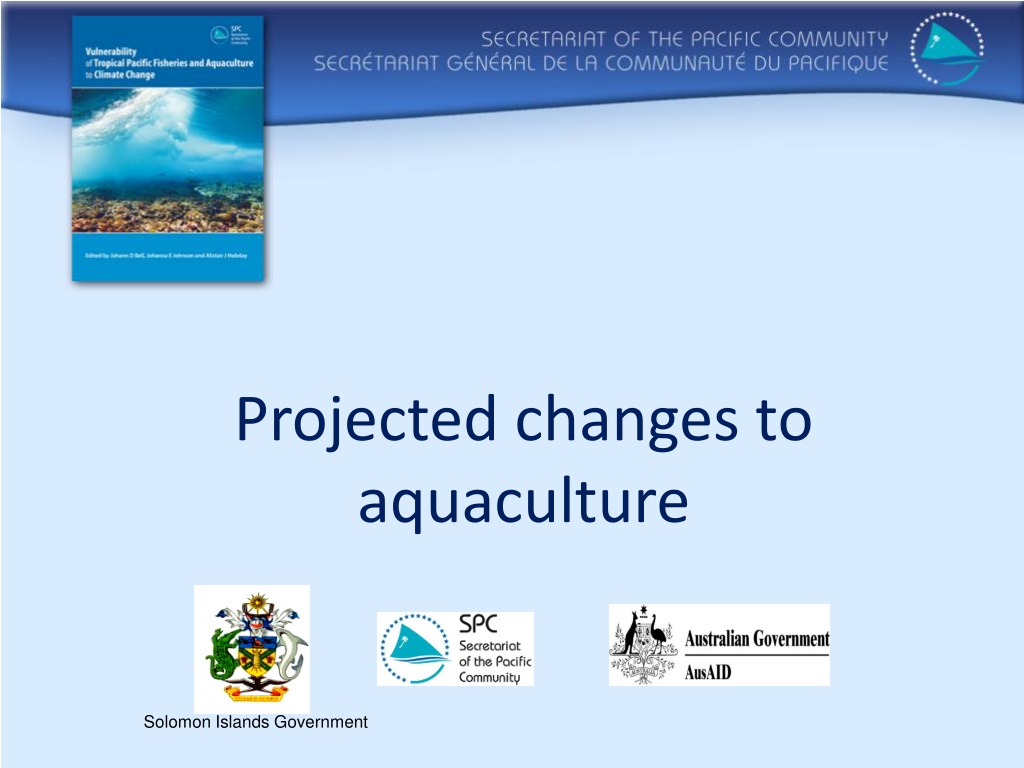
Aquaculture Developments in Solomon Islands Government
This detailed report explores the projected changes to aquaculture in the Solomon Islands Government. It covers freshwater aquaculture focusing on tilapia, milkfish, and freshwater prawn, as well as coastal aquaculture including pearls, seaweed, and marine ornamentals. The vulnerability of both freshwater and coastal aquaculture is examined, along with specific practices like tilapia farming, household subsistence production, livelihoods, and expansion in the region. The report also addresses the benefits and risks associated with climate change on tilapia and freshwater prawn farming. Recommendations are provided to respond to challenges such as flooding and de-oxygenation in aquaculture.
Download Presentation

Please find below an Image/Link to download the presentation.
The content on the website is provided AS IS for your information and personal use only. It may not be sold, licensed, or shared on other websites without obtaining consent from the author. Download presentation by click this link. If you encounter any issues during the download, it is possible that the publisher has removed the file from their server.
E N D
Presentation Transcript
Projected changes to aquaculture Solomon Islands Government
Outline Freshwater aquaculture (tilapia, milkfish, freshwater prawn) Vulnerability of freshwater aquaculture Coastal aquaculture (pearls, seaweed, marine ornamentals) Vulnerability of coastal aquaculture
Tilapia Food security Lake restocking to replace Mossambique Tilapia with Nile Tilapia Household subsistence production
Tilapia Livelihoods Cage culture Semi-intensive ponds Aquaponics
Tilapia Tilapia farming is expanding in the region PNG 10-15,000 Fiji produces 200-300 tonnes per year Samoa has 25 farms Hatchery established in Vanuatu
Milkfish 30 80 t per year in Guam 5 15 t per year in Kiribati Four farms in Palau Capture-based culture trials in Fiji, Solomon Islands and Tonga Brackish ponds Freshwater ponds Cage culture for food, tuna-bait
Freshwater prawn Macrobrachium Hatchery-based culture (M. rosenbergii) Capture-based culture (M. lar) Fiji produces about 25 t per year
Vulnerability of freshwater aquaculture
Tilapia, freshwater prawn Likely to benefit from climate change Higher rainfall and warmer temperatures will allow farming in more places and at higher altitudes
Tilapia, freshwater prawn Increased risks from flooding Stratification from higher temperatures causes de-oxygenation
How should we respond? Build fish ponds to avoid more severe floods Photo: Avinash Singh
How should we respond? Increase aeration to combat stratification
Milkfish Increased temperatures will extend the geographical range and season of fry collection Risk from ocean acidification?
Conclusion Freshwater pond aquaculture is likely to be favoured by climate change Source: Pickering et al. (2011)
Ocean acidification Source: IPCC (2007), Ganachaud et al. (2011)
Temperature 2035 2050* Spatial variation in temperature increase 2035 2100 Source: Lough et al. (2011) * Based on B1 2100
Acidification and temperature Acidification expected to affect pearl oyster larvae, juveniles and adults Acidification and increased temperature likely to reduce pearl quality High-quality Fiji Pearls Poor lustre, defects
Temperature and increased rainfall Ice-ice Kappaphycus seaweed is vulnerable to: temperature >30oC lower salinity These conditions cause ice-ice and Epiphytic Filamentous Algae (EFA) outbreaks EFA
Summary Pearls 2035 2050 2100 Effects due to: Increased temperature Ocean acidification Greater runoff Sea-level rise More-intense cyclones Seaweed Marine ornamentals
How should we respond? Expect production losses from extreme events and unexpected causes Ensure that financial planning for enterprises can absorb such shocks Photos: Cathy Hair
How should we adapt? Grow pearls at greater depth for final nacre
How should we adapt? Long term data collection to identify sites where conditions for nacre growth may be better Progressively switch to hatchery production and selective breeding
How should we adapt? Select sites for seaweed farms near upwelling areas and at low risk from increased freshwater runoff Use temperature- and salinity-tolerant strains to avoid ice-ice and EFA Photo: Gideon Tiroba
How should we adapt? Grow ornamentals at greater depth (cooler waters) Identify sites where CO2 is reduced
Pearl farming Difficult to predict effects of future production until more is known about consequences of ocean acidification
Kappaphycus seaweed Medium-term production targets of around 1000 tonnes per year should still be achievable But not in the same places, by the same methods, or with the same varieties
Conclusion Scope for development over next 30-40 years Production efficiency is likely to be reduced
